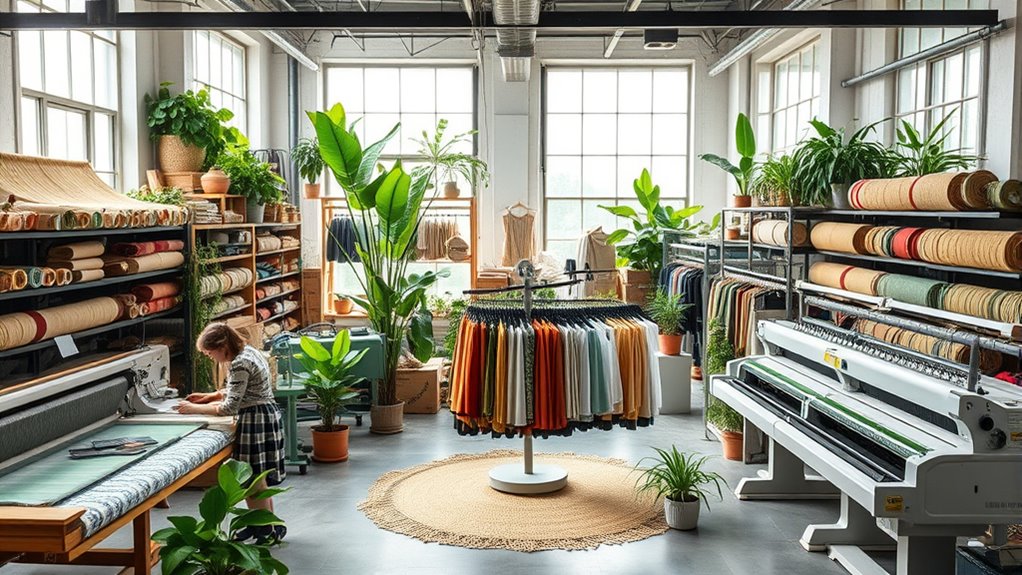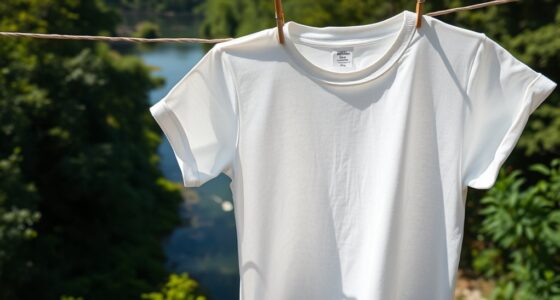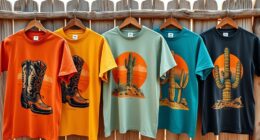The fashion industry is shifting toward closed-loop systems by embracing recycling, sustainable sourcing, and innovative design. Brands are transforming old garments into new fabrics and designing for recyclability, reducing waste and conserving resources. They’re also sourcing recycled or eco-friendly materials and adopting technologies that help create a circular economy. This movement aims to minimize environmental impact and promote reuse, repair, and regeneration. If you want to understand how this sustainable change continues to grow, keep exploring these strategies.
Key Takeaways
- The industry is adopting textile recycling technologies to transform old garments into new fibers, promoting a circular economy.
- Brands are designing products for recyclability and investing in closed-loop systems to minimize waste.
- Sustainable sourcing practices prioritize recycled and eco-friendly materials, reducing environmental impact from the start.
- Consumer awareness and demand are driving brands to embrace circular models emphasizing reuse, repair, and regeneration.
- Technological innovations support closed-loop systems, enabling the industry to shift from linear to sustainable, regenerative fashion practices.

Have you ever wondered how fashion can be more sustainable? The industry is shifting toward circular models that reduce waste and conserve resources. One of the key ways this is happening is through textile recycling, which transforms old garments into new fabrics, minimizing the need for virgin materials. Instead of discarding worn-out clothes, brands are now designing for recyclability and investing in innovative recycling technologies. This approach not only diverts textiles from landfills but also lowers the environmental footprint by reusing fibers already in circulation. It’s a smart move that aligns with the principles of sustainable sourcing, where companies prioritize ethically and environmentally responsible materials from the very beginning.
When you buy clothes made from recycled textiles, you participate in a cycle that keeps resources in use longer. Textile recycling involves breaking down existing fabrics—whether cotton, polyester, or blends—into fibers that can be spun into new yarns. This process reduces the demand for water, energy, and chemicals typically used in traditional fabric production. By supporting brands that champion textile recycling, you help shift the industry toward a more circular economy, where waste is minimized and materials are kept in use for as long as possible. Sustainable sourcing complements this effort by ensuring that the raw materials used are responsibly harvested, whether through organic farming, fair labor practices, or eco-friendly extraction methods.
Manufacturers are increasingly sourcing fibers that are either recycled or sustainably produced, creating a supply chain that’s transparent and ethical. This means fewer chemicals, less water, and lower greenhouse gas emissions—benefits that extend beyond the environment to social responsibility. When brands commit to sustainable sourcing, they often work with suppliers who adhere to strict standards, ensuring that every step of the process is environmentally sound and socially equitable. As a consumer, you can choose to support these brands, knowing that your purchase contributes to a more sustainable future.
The integration of textile recycling and sustainable sourcing is transforming fashion into a more circular system. It’s about designing clothes with their life cycle in mind, making it easier to recycle and reuse. It’s about sourcing materials that have a lower environmental impact from the start. And it’s about shifting the industry’s mindset from linear—take, make, dispose—to one that prioritizes reuse, repair, and regeneration. By understanding these concepts and supporting brands that embrace them, you play a vital role in fostering a more responsible and sustainable fashion industry. Embracing innovative recycling technologies can further accelerate this positive change, ensuring that the industry continues to evolve in an environmentally conscious direction.
Frequently Asked Questions
What Materials Are Most Sustainable for Circular Fashion?
You should prioritize recycled textiles and biodegradable fibers for sustainable circular fashion. Recycled textiles, like recycled polyester or cotton, reduce waste and resource use, making your wardrobe more eco-friendly. Biodegradable fibers, such as Tencel or hemp, break down naturally without harming the environment. By choosing these materials, you actively support closed-loop systems and help minimize textile waste, ensuring fashion stays sustainable and environmentally responsible.
How Do Consumers Participate in Closed-Loop Systems?
Ever wondered how you can help close the loop? You participate by engaging in recycling initiatives, returning your used clothes for repurposing or recycling. Your consumer engagement is essential, as it encourages brands to develop sustainable practices. By choosing to recycle and support brands with closed-loop systems, you reduce waste and promote sustainability. Isn’t it empowering to be part of a solution that transforms fashion into a circular, eco-friendly cycle?
What Are the Main Challenges Brands Face Adopting Circular Models?
You’ll face challenges adopting circular models due to supply chain complexity and limited consumer awareness. Managing multiple suppliers, ensuring proper recycling or reuse, and maintaining transparency can be tough. Additionally, educating consumers about the benefits and encouraging participation requires strategic effort. These hurdles demand innovation, collaboration, and clear communication, but overcoming them helps you build a sustainable brand that aligns with growing eco-conscious expectations.
How Does Circular Fashion Impact Garment Quality and Durability?
Think of circular fashion as a never-ending story where your garments become timeless. You’ll find that it often enhances fabric longevity and design durability, making your clothes last longer. By focusing on quality materials and thoughtful construction, brands guarantee that garments withstand repeated cycles of reuse. So, embracing this system means you enjoy more durable pieces that maintain their beauty, turning fleeting fashion into sustainable style.
Are There Any Legal Regulations Promoting Circularity in Fashion?
Yes, legal regulations promote circularity in fashion through incentives and frameworks. You’ll find governments implementing policies that encourage sustainable practices, such as tax breaks for eco-friendly brands and mandatory recycling targets. These regulatory frameworks motivate you to adopt closed-loop systems, reduce waste, and improve sustainability. By aligning with legal incentives, you can innovate in circular fashion, helping the industry reduce environmental impact while staying compliant with evolving regulations.
Conclusion
By embracing circular fashion, you become part of a sustainable cycle, sparking positive change and prioritizing planet-friendly practices. As you support systems that recycle, reuse, and rethink, you help shape a smarter, more sustainable style. Let’s lead the way with mindful movement, making meaningful impacts through mindful methods. Together, we can create a cleaner, circular couture that continues to cherish, conserve, and champion our world’s wonders. Your choices make a difference—so choose circular, and champion change.









